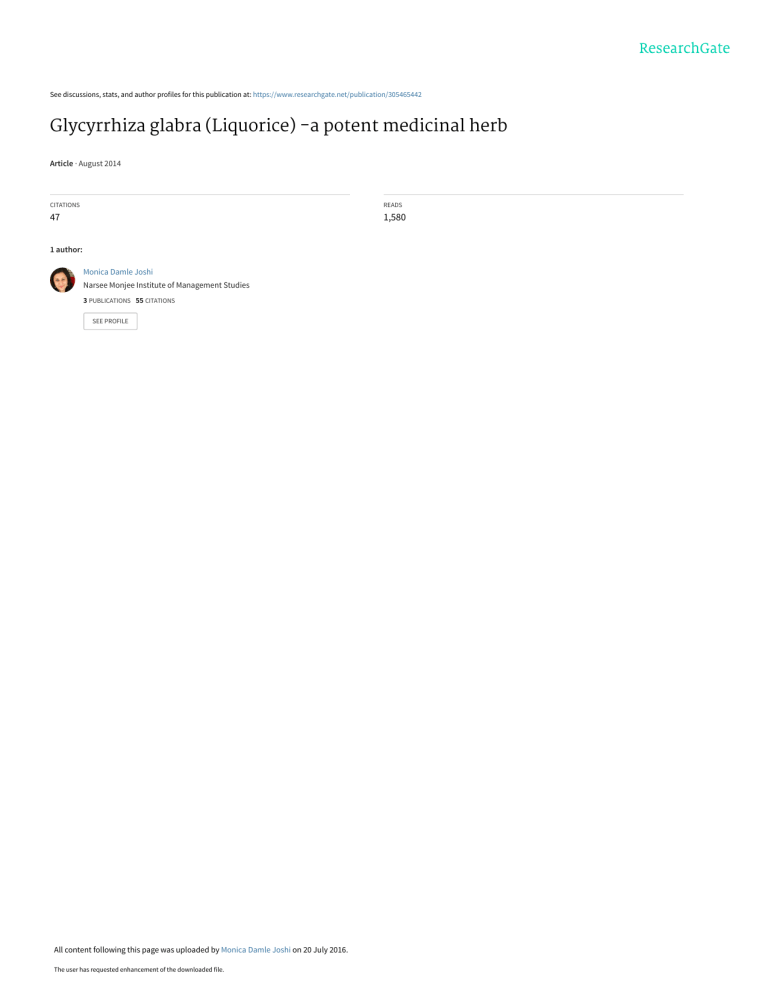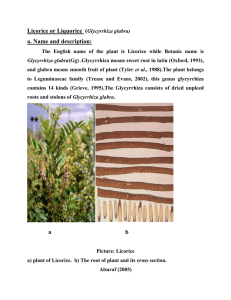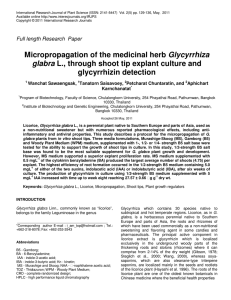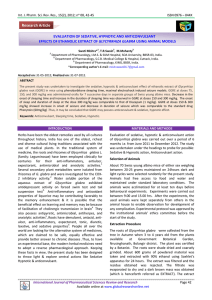
See discussions, stats, and author profiles for this publication at: https://www.researchgate.net/publication/305465442 Glycyrrhiza glabra (Liquorice) -a potent medicinal herb Article · August 2014 CITATIONS READS 47 1,580 1 author: Monica Damle Joshi Narsee Monjee Institute of Management Studies 3 PUBLICATIONS 55 CITATIONS SEE PROFILE All content following this page was uploaded by Monica Damle Joshi on 20 July 2016. The user has requested enhancement of the downloaded file. International Journal of Herbal Medicine 2014; 2(2): 132-136 ISSN 2321-2187 IJHM 2014; 2(2): 132-136 Received: 13-07-2014 Accepted: 20-08-2014 Glycyrrhiza glabra (Liquorice) - a potent medicinal herb Monica Damle SVKM’s Dr. Bhanuben Nanavati College of Pharmacy Gate No.1, 1st Floor, Mithibai College Campus, V.M. Road , Vile Parle (West), Mumbai 400 056, India. Abstract There is an increasing demand for herbal medicines, health products, pharmaceuticals. Glycyrrhiza glabra Linn is a plant used in traditional medicine across the world for its ethnopharmacological value. It is found to contain important phytoconstituents such as glycyrrhizin, glycyrrhizinic acid, glabrin A and B and isoflavones. It is effectively used as anti-inflammatory, anti-bacterial, anti-fungal, anti-diabetic, antiviral, anti-ulcer, antitussive, anti-oxidant, skin whitening, anti-diuretic agent. The present article is an effort to compile the available literature on Glycyrrhiza glabra with respect to its traditional uses, bioactive constituents and pharmacologic activities. This may be useful in discovering potential therapeutic effects and developing new formulations. Monica Damle Keywords: Glycyrrhiza glabra, glycyrrhizin, antitussive, anti-oxidant, skin lightening 1. Introduction Incontrovertibly there are worldwide changes in healthcare industry in the third millennium. Ayurvedic system of healthcare has gained importance and is becoming popular. It is a comprehensive system of healthcare that originated in India. Because of the effectiveness and less adverse reactions compared to the synthetic chemicals, Ayurvedic system has attained popularity globally. The classical text of Ayurveda mentions number of plants for the management of several diseases. Undoubtedly several researchers had given their contributions for finding hidden therapeutic potentials of number of Ayurvedic drugs, but still number of plants need a comprehensive study on them. Therefore the present study is focused on one such very effective and potent medicinal herb- Glycyrrhiza glabra [1]. Glycyrrhiza glabra Linn is one of the most extensively used medicinal herb from the ancient medical history of Ayurveda. It is also used as a flavoring herb. The word Glycyrrhiza is derived from the Greek term glykos (meaning sweet) and rhiza (meaning root). Glycyrrhiza glabra Linn, commonly known as ‘liquorice’ and ‘sweet wood’ belongs to Leguminosae family. Vernacular names for liquorice are Jeshthamadh (Marathi), Jothi‐madh (Hindi), Yashtimadhu, Madhuka (Sanskrit), Jashtimadhu, Jaishbomodhu (Bengali), Atimadhuram, Yashtimadhukam (Telugu), Jethimadhu (Gujarati) and Atimadhuram (Tamil) [2]. Correspondence: Monica Damle SVKM’s Dr. Bhanuben Nanavati College of Pharmacy Gate No.1, 1st Floor, Mithibai College Campus, V.M. Road , Vile Parle (West), Mumbai 400 056, India. Fig 1: Glycyrrhiza glabra plant Fig 2: Glycyrrhiza glabra root 2. Scientific Classification Kingdom: Plantae Division: Angiospermae Class: Dicotyledoneae Order: Rosales Family: Leguminosae Genus: Glycyrrhiza Species: glabra Linn ~ 132 ~ International Journal of Herbal Medicine 3. Traditional Uses In traditional medicine, liquorice has been recommended as a prophylactic agent for gastric and duodenal ulcers. It is employed in dyspepsia as an anti-inflammatory agent during allergenic reactions [3]. It is used as a contraceptive, laxative, anti-asthmatic, emmenagogue, galactagogue, antiviral agent in folk therapy [4]. Glycyrrhiza roots are useful for treating cough because of its demulcent and expectorant property [5] . It is also effective against anemia, gout, sore throat, tonsillitis, flatulence, sexual debility, hyperdypsia, fever, skin diseases, swellings. Liquorice is effectively used in acidity, leucorrhoea, bleeding, jaundice, hiccough, hoarseness, bronchitis, vitiated conditions of Vata dosha, gastralgia, diarrhea, fever with delirium and anuria [6, 7]. It is a vital ingredient in medicinal oils used for the treatment of rheumatism, hemorrhagic diseases, epilepsy and paralysis [7] . It has been proved by several years of research that, glycyrrhizin breaks down in the gut and exerts antiinflammatory action similar to hydrocortisone and other corticosteroid hormones. The effect is due to stimulation of hormone production by adrenal glands and reduction in the breakdown of steroids by the liver and kidneys. Effectiveness of glycyrrhizin in the treatment of chronic hepatitis and liver cirrhosis is proved [8]. Glycyrrhiza glabra is considered as one of the best remedies for relieving pain and other symptoms such as discomfort caused by acrid matter in the stomach. It alleviates the irritating effects of acids in a better way than alkalies [9]. It is an excellent tonic and is also used as demulcent in catarrh of the genitourinary passages [10]. 4. Bioactive constituents A large number of components have been isolated from the liquorice roots. 40-50 percent of total dry material weight of Glycyrrhiza glabra is accounted by water-soluble, biologically active complex. Starches (30%), pectins, polysaccharides, simple sugars, gums, mucilage (Rhizome), amino acids, triterpene saponin, flavonoids, mineral salts, bitters, essential oil, fat, asparagines, female hormone estrogen, tannins, glycosides, protein, resins, sterols, volatile oils and various other substances are components of this complex [11, 12]. The primary active ingredient, Glycyrrhizin (glycyrrhizic acid; glycyrrhizinate) constitutes 10–25% of liquorice root extract. It is a saponin compound (60 times sweeter than cane sugar) comprised of a triterpenoid aglycone, glycyrrhetic acid (glycyrrhetinic acid; enoxolone) conjugated to a disaccharide of glucuronic acid. Glycyrrhizin and glycyrrhetic acid can exist in the 18α and 18β stereoisomer forms [13]. Glycyrrhizin is considered to be the most common of the Asiatic folk medicines to be used as an anti-inflammatory agent on neutrophil functions including ROS (reactive oxygen species) generation.14 Thus, Glycyrrhizin is considered as quenching agent of free radicals and also as blocking agent of lipid peroxidation chain reactions. Glycyrrhizin showed chemopreventive, antioxidant, and antiproliferative activity when tested on animal model [14]. Glycyrrhizin (a tribasic acid), can form a variety of salts. In liquorice, it occurs naturally as calcium and potassium salts. The ammoniated salt of glycyrrhizin is manufactured from liquorice extracts. The specifications for this salt form have been established in the Food Chemicals Codex. This salt is used as a food flavoring agent [13, 15]. An analog of glycyrrhetic acid, Carbenoxolone (18βglycyrrhetinic acid hydrogen succinate) is useful in the treatment of alimentary tract ulcerative conditions like peptic ulcers [16]. The yellow color of liquorice is because of the flavonoid content of the plant. Flavonoids include liquiritin, a chalcone (isoliquiritin) and other compounds [17]. Flavonoid rich fractions include liquirtin, isoliquertin, liquiritigenin and rhamnoliquirilin. Five new flavonoids- glucoliquiritin apioside, shinflavanone, shinpterocarpin, prenyllicoflavone A, and 1-methoxyphaseolin are isolated from dried roots [18]. The isoflavones glabridin and hispaglabridins A and B have considerable antioxidant activity. Both glabridin and glabrene have estrogen-like activity [19]. Many volatile components are present in roots e.g. geraniol, pentanol, hexanol, terpinen-4-ol, α-terpineol. Isolation of various compounds like propionic acid, benzoic acid, furfuraldehyde, 2,3 butanediol, furfuryl formate, maltol, 1-methyl-2formylpyrrole, trimethylpyrazine etc from the essential oil is also reported [20]. The Indian variety of liquorice roots show 2-methyliso – flavones and C liquocoumarin, 6 - acetyl- 5, hydroxy-4- methylcoumarin (unusual coumarin). Asparagine is also present [21]. 5. Reported Pharmacological activities 5.1 Anti-tussive & expectorant activity The liquorice powder and extract was found to be effective in treatment of sore throat, cough and bronchial catarrh. The specific mechanism of action is not known. Liquorice has been shown to work as efficiently as codeine in sore throat. It decreases irritation and produces expectorant effects. Carbenoxolone (a semi synthetic compound derived from Glycyrrhiza) stimulates gastric mucus secretion. Likewise, liquorice extract may also be able to stimulate tracheal mucus secretions producing demulcent and expectorant effects.22 Glycyrrhizin is responsible for demulcent action of liquorice. Liquiritin apioside, an active compound present in the methanolic extract of liquorice which inhibits capsaicin induced cough [23]. Ethanolic extract of G. glabra was found to be responsible for inhibition of 35.62% SO2 gas induced cough in experimental animals (mice) [24]. 5.2 Antioxidant activity High content of phenolic component in ethanolic extract of Liquorice (Glycyrrhiza glabra L) is responsible for its powerful antioxidant activity by means of significant free radical scavenging, hydrogen-donating, metal ion chelating, anti-lipid peroxidative and reducing abilities [25]. Liquorice flavonoids have exceptionally strong antioxidant activity. Antioxidant activity of liquorice flavonoids was found to be over 100 times stronger than that of antioxidant activity of vitamin E. A dose of 2.58 mg/ml liquorice flavonoids can scavenge more free radicals (20.6% scavenging) than 258 mg/ml of vitamin E (11.2% scavenging). Ju, H.S. reported that flavonoids from liquorice are currently the strongest natural antioxidants known [26]. Thus, liquorice extract can be efficiently used to formulate cosmetic products for the protection of skin and hair against oxidative damage [27]. 5.3 Skin lightening and skin tightening activity The extract of liquorice is reported to be an effective pigment-lightening agent. It is the safest pigment-lightening agent known with least side effects. Glabridin in the hydrophobic fraction of liquorice extract inhibits tyrosinase activity in cultured B16 murine melanoma cells. It does not affect DNA synthesis. Some other active compounds in liquorice extract like glabrene, Licochalcone A, Isoliquiritin are also responsible for inhibition of tyrosinase activity. ~ 133 ~ International Journal of Herbal Medicine Liquiritin present in liquorice extract disperse melanin, thereby inducing skin lightening [28]. Also the antioxidants present in extract may contribute to decrease in skin melanin content [29]. In vitro tyrosinase enzyme inhibition studies has showed that 21.2 μg/ml of methanolic extract of liquorice caused 50% tyrosinase enzyme inhibition. The inhibition of tyrosinase enzyme and reduction in enzyme activity is caused due to modification of action site of the enzyme. Due to good tyrosinase inhibition activity, liquorice extract can be used to formulate cosmetic formulations with depigmenting activity.30 Ethanolic extract of Glycyrrhiza glabra is reported to show improvement in the viscoelastic and hydration properties of the skin. Synergistic effect of UV protective, antioxidant and anti-inflammatory properties of liquorice extract might be responsible for giving beneficial effects on skin [31]. 5.4 Anti-inflammatory activity Liquorice root (Glycyrrhiza) extract promotes the healing of ulcers of the stomach and mouth. The fact was known for over 2000 years. But the scientific studies for finding out possible mechanism began in 1950’s. It is reported that glycyrrhetinic acid in liquorice extract gives antiinflammatory effect similar to glucocorticoids and mineralocorticoids [32]. According to In vitro studies, glycyrrhizic acid inhibits all factors responsible for inflammation. It inhibits cyclooxygenase activity and prostaglandin formation (specifically prostaglandin E2). It is also responsible for indirectly inhibiting platelet aggregation [33, 34]. Carbenoxolone (Biogastron), a glycyrrhetinic acid analog, is reported to inhibit two enzymes that are important in metabolism of prostaglandin, 15-hydroxyprostaglandin dehydrogenase and Δ13 prostaglandin thereby raising prostaglandin levels. Prostaglandins stimulate mucous secretion and cell proliferation. Thus, ulcer healing is promoted [32]. 5.5 Anti-viral effects It is reported that liquorice extract inhibits the growth of viruses, including herpes simplex, Varicella zoster, and of Japanese encephalitis, influenza virus, vesicular stomatitis virus, type A influenza virus [27, 35, 36, 37]. Glycyrrhizin does not allow the virus cell binding. Thus, it is found to have a prominent antiviral activity. It has been previously employed in the treatment of HIV-1 and chronic hepatitis C. Recent study on two clinical isolates of SARS virus (Severe Acute Respiratory Syndrome virus) [FFM-1 and FFM-2] gave valuable insight about anti-viral activity of glycyrrhizin. The study was carried out on patients with SARS, admitted to clinical center of Frankfurt University, Germany. This study on antiviral activities of ribavirin, 6-azauridine, pyrazofurin, mycophenolic acid and glycyrrhizin proved that glycyrrhizin was the most efficient in controlling viral replication. Thus, it can be a good prophylactic measure [35, 38, 39, 40]. Glycyrrhizic acid was found to have a distinctive effect against Kaposi sarcoma-associated herpes virus (KSHV) as found in In vitro studies. KSHV also becomes latent in infected cells same as other herpes virus. As a consequence, complete eradication of the virus becomes difficult. It is proved that glycyrrhizic acid can terminate latent infection of KSHV when all current drugs are found to be ineffective against latent infection. Glycyrrihizic acid down-regulates the expression of latency associated nuclear antigen (LANA) in B lymphocytes. This causes natural cell death (apoptosis) of the KSHV virus [41]. 5.6 Anti-fungal activity Methanolic extract of liquorice was reported to have fungicidal activity against Arthrinium sacchari M001 and Chaetomium funicola M002. Glabridin was found to be the active compound giving anti-fungal activity [42]. Isoflavonoids such as glabridin, glabrol and their derivatives are responsible for in vivo inhibition of Mycobacterium smegmatis and Candida albicans [27]. Thus, liquorice extract has a great potential in formulating cosmetic products with antiseptic activities. 5.7 Anti-bacterial Activity Because of the presence of secondary metabolites such as; saponins, alkaloids, flavonoids in hydro-methanolic root extract of Glycyrrhiza glabra, the extract exhibits potent antibacterial activity [43]. In vitro studies have proved that aqueous and ethanolic extracts of liquorice show inhibitory activity on cultures of Staphylococcus aureus and Streptococcus pyogenes [27]. 5.8 Anti-malarial activity Licochalcone A (a chalcone) present in liquorice has reported to possess very good antimalarial activity. All Glycyrrhiza species have this compound in different amounts and it can be isolated from them. In vivo studies against P. yoelii in mice with oral doses of 1000 mg kg-1 have shown to eradicate malarial parasite completely. Also no toxicity was observed [44]. 5.9 Anti hyperglycemic activity The effect of liquorice extract on serum lipid profile and liver enzymes was studied in albino mice. Root extract of Glycyrrhiza glabra was found to have anti-lipidemic and anti-hyperglycemic activity at low doses [45]. 5.10 Immunostimulatory effects In vitro studies proved that Glycyrrhiza glabra at 100μg/ml concentration, showed immunostimulatory effects. It increases production of TCD69 lymphocytes and macrophages from human granulocytes. According to in vivo studies, liquorice root extract was found to prevent the rise in the amount of immune-complexes related to autoimmune diseases like systemic lupus erythematosus [27]. 5.11 Memory enhancing activity The effects of Glycyrrhiza glabra on learning and memory was investigated in mice. Elevated plus-maze and passive avoidance paradigm were used to test learning and memory. Three doses of aqueous extract of liquorice were administered [75, 150 and 300 mg/kg p.o.]. The study was conducted for 7 successive days in separate groups of animals. Significant improvement in learning and memory of mice was reported at the dose of 150 mg/kg. But, the exact mechanism of action is unknown and needs further investigation [46]. 5.12 Hepatoprotective activity Glycyrrhizin significantly inhibits the CCl4- induced release of AST and LDH at concentrations of 25–200 μg/ml. Alteration of membrane fluidity by the glycyrrhizin or inhibition of CCl4-induced membrane lipid peroxidation might be responsible for the activity. 18β-glycyrrhetic acid (an aglycone of glycyrrhizic acid) shows hepatoprotective activity by inhibiting both free radical generation and lipid ~ 134 ~ International Journal of Herbal Medicine peroxidation [47]. Glycyrrhizin is useful in treating acetaminophen-induced hepatotoxicity [48]. Liquorice extract is proved to show hepatoprotective activity against diclofenac –induced hepatotoxicity in rats [49]. 5.13 Anticoagulant Glycyrrhizin is the first plant based inhibitor of thrombin. It is found to prolong the thrombin and fibrinogen clotting time. It also increases plasma recalcification duration. Glycyrrhizin causes inhibition in thrombin induced platelet aggregation. But there was no effect of glycyrrhizin on Platelet Aggregating Factor (PAF) and Collagen induced agglutination [50, 51]. 5.14 Hair growth stimulatory activity The hydro-alcoholic extract of liquorice showed good hair growth promoting activity. Comparison between liquorice extract and the standard drug used (Minoxidil 2%) showed that, 2% concentration of liquorice extract showed better hair growth stimulatory activity than 2% Minoxidil. Thus, after efficacy and safety analysis, it has been be concluded that, liquorice has a significant hair growth activity and it can be safely used in herbal formulations in treatment of various types of Alopecia [52]. 6. Conclusion Liquorice (Glycyrrhiza glabra Linn) is a plant with ethnopharmacological importance. The present review was mainly focused on pharmacological activities of liquorice. The review would help in further studies on Glycyrrhiza glabra Linn for exploring its potential in preventing and treating diseases. 7. References 1. Kataria R, Hemraj, Singh G, Gupta A, Jalhan S, Jindal A et al. Pharmacological activities on Glycyrrhiza glabra– a review, Asian J Pharm Clin Res 2013; 6(1):5-7. 2. Chopra RN, Nayar SL, Chopra IC. Glossary of Indian Medicinal Plants. New Delhi, NISCAIR, CSIR, 2002. 3. Ammosov S, Litvinenko VI. Triterpenoids of Plants of Glycyrrhiza L. and Meristotropis Fisch. Et Mey Genuses, Pharm Chem J 2003; 37:83-94. 4. Saxena S. Glycyrrhiza glabra: Medicine over the millennium, Natural product radiance 2005; 4(5):358367. 5. Glycyrrhiza final. http://openmed.nic.in/3195/01/. 10 May 2014. 6. Sheth A. The Herbs of India. Edn 1, Vol 2, Hi Scan Pvt Ltd, Gujrat, 2005, 566. 7. Kaur R, Kaur, Dhinds AS. Glycyrrhiza glabra: a phytopharmacological review, IJPSR 2013; 4(7):24702477. 8. Khare CP. Encyclopedia of Indian Medicinal Plants. Springer-Verlag, New York, 2004, 233-5. 9. Chopra RN, Chopra IC. Indigenous Drugs of India. Edn 2, Academic Publishers, Kolkata, 1958, 183-7. 10. Nadkarni KM. Indian Materia Medica, Popular Prakashan Pvt. Ltd., Mumbai, 1976, 582-4. 11. Bradley PR. British Herbal Compendium, 1, BHMA, Bournemouth, 1992. 12. Hoffmann D. The New Holistic Herbal, Edn 2, Element, Shaftesbury, 1990. 13. Food Chemicals Codex, Edn 5, National Academy Press, Washington DC, 2003, 25. 14. Rahman S, Sultana S. Glycyrrhizin exhibits potential chemopreventive activity on 12-O-tetradecanoyl phorbol-13-acetate-induced cutaneous oxidative stress and tumor promotion in Swiss albino mice. Journal of Enzyme Inhibition and Medicinal Chemistry 2007; 22(3):363-369. 15. Wang ZY, Athar M, Bickers DR. Licorice in foods and herbal drugs: Chemistry, pharmacology, toxicology and uses. In Herbs, Botanicals & Teas, Mezza G, Oomah BD eds, Technomic Publishing Co. Inc, Lancaster, 2000, 321-353. 16. Isbrucker RA, Burdock GA. Regulatory Toxicology and Pharmacology, 2006, 46:167-192. 17. Yamamura Y, Kawakami J, Santa T. Pharmacokinetic profile of glycyrrhizin in healthy volunteers by a new high-performance liquid chromatographic method. J Pharm Sci 1992; 81:1042-1046. 18. The wealth of India. A Dictionary of Indian Raw Materials and Industrial Products, First supplement series, National Institute of Sciences Communication and Information Resources, Vol 3, CSIR, New Delhi, 2005, D-1, 195-198. 19. Vaya J, Belinky PA, Aviram M. Antioxidant constituents from licorice roots: isolation, structure elucidation and antioxidative capacity toward LDL oxidation, Free Radic Biol Med 1997; 23:302-313. 20. Tamir S, Eizenberg M, Somjen D. Estrogen like activity of glabrene and other constituents isolated from licorice root. J Steroid Biochem Mol Biol 2001; 78:291-298. 21. Li W, Asada Y, Yoshikawa T. Flavonoid constituents from Glycyrrhiza glabra Linn hairy root cultures, Phytochemistry 2000; 55(5):447-56. 22. Murray WJ. Herbal Medications for Gastrointestinal Problems, Herbal Medicinals- A Clinician’s Guide, Pharmaceutical Products Press, New York, 1998, 79-93. 23. Kamei J, Nakamura R, Ichiki H, Kubo M. Antitussive principles of Glycyrrhiza radix, a main component of Kampo preparations Bakumondo-to (Mai-men-dongtang). E J Pharm 2003; 69:159-163. 24. Jahan Y, Siddique HH. Study of antitussive potential of Glycyrrhiza glabra & Adhatoda vasica using a cough model induced by SO2 gas in mice, International Journal of Pharmaceutical Sciences & Research 2012; 3:166874. 25. Visavadiya NP, Soni B, Dalwadi N. Evaluation of antioxidant and anti-atherogenic properties of Glycyrrhiza glabra root using In vitro models. International Journal of Food Sciences and Nutrition 2009; 60(2):135-149. 26. Ju HS, Li XJ, Zhao BL, Han ZW, Xin WJ. Effects of Glycyrrhiza Flavonoids on lipid peroxidation and active oxygen radicals. Acta Pharmaceutica Sinicia 1989; 24(11):807-812. 27. Alonso J. Tratado de Fitofármacos y Nutracéuticos. www.fitoterapia.net. Barcelona: Corpus, 2004; 905-911. 28. Cronin H, Draelos ZD. Top 10 botanical ingredients in 2010 anti-aging creams. Journal of Cosmetic Dermatology 2010; 9(3):218-225. 29. Nohata, Yasuhiro K, Tomomi. Japan Patent 2002029929; 2005. 30. Zuidhoff HW, Rijsbergen JMV. Whitening Efficacy of Frequently Used Whitenning Ingredients, C&T 2001; 116(1):53-59. 31. Ahshawat MS, Saraf S, Saraf S. Preparation and ~ 135 ~ International Journal of Herbal Medicine 32. 33. 34. 35. 36. 37. 38. 39. 40. 41. 42. 43. 44. 45. 46. 47. 48. characterization of herbal creams for improvement of skin viscoelastic properties. International Journal of Cosmetic Science 2008; 30(3):183-193. Baker ME. Licorice and enzymes other than 11hydroxysteroid dehydrogenase: An evolutionary perspective, Steroids 1994; 59:136-141. Okimasu E, Moromizato Y, Watanabe S. Inhibition of phospholipase A2 and platelet aggregation by glycyrrhizin, an anti-inflammatory drug. Acta Med Okayama 1983; 37:385-391. Ohuchi K, Tsurufuji A. A study of the anti-inflammatory mechanism of glycyrrhizin. Mino Med Rev 1982; 27:188-193. Adam L. In vitro antiviral activity of indigenous glycyrrhizin, licorice and glycyrrhizic acid (Sigma) on Japanese encephalitis virus. J Commun Dis 1997; 29(2):91-99. Pompei R, Pani A, Flore O, Marcialis MA, Loddo B. Antiviral activity of glycyrrhizic acid. Experientia 1980; 36:304. Pompei R, Flore O, Marcialis MA, Pani A, Loddo B. Glycyrrhizic acid inhibits virus growth and inactivates virus particles, Nature 1979; 281(5733):689-90. De-Clercq E. Current lead natural products for the chemotherapy of human immunodeficiency virus (HIV) infection, Med Res Rev 2000; 20:323-349. Cinatl J, Morgenstern B, Bauer G, Chandra P, Rabenau H, Doerr HW. Glycyrrhizin, an active component of liquorice roots, and replication of SARS-associated coronavirus. Lancet 2003; 361(9374):2045-6. Aadam L. In vitro studies on the effect of glycyrrhizin from Glycyrrhizin glabra on some RNA and DNA viruses. Indian J Pharmacol 1994; 26:194-199. Curreli F, Friedman K, A Flore O. Glycyrrhizic acid alters Kaposi sarcoma-associated herpesvirus latency, triggering p53 mediated apoptosis in transformed B lymphocytes. J Clin Invest 2005; 115:642-52. Hojo H, Sato J. Antifungal Activity of Licorice (Glycyrrhiza glabra Linn) and Potential Applications in Beverage Foods. J Food Ingredients Japan, 2002; 203. Sharma V, Agrawal RC, Pandey S. Phytochemical screening and determination of anti-bacterial and antioxidant potential of Glycyrrhiza glabra root extracts. J Environ Res Develop 2013; 7(4A):1552-1558. Sianne S, Fanie RVH. Antimalarial activity of plant metabolites. Nat Prod Rep 2002; 19:675-692. Revers FE. Clinical and pharmacological investigations on extract of licorice. Acta Medica Scandinavica 1956; 154:749-751. Dhingra D, Parle M, Kulkarni SK. Memory enhancing activity of Glycyrrhiza glabra Linn in mice. J Ethnopharmacology 2004; 91(2-3):361-365. Jeong HG, You HJ, Park SJ, Moon AR, Chung YC, Kang SK et al. Hepatoprotective effects of 18βglycyrrhetinic acid on carbon tetrachloride-induced liver injury: inhibition of cytochrome P450 2E1 expression, Pharmacological Research 2002; 46:221-227. Xu-ying W, Ming L, Xiao-dong L and Ping H. Hepatoprotective and anti hepatocarcinogenic effects of glycyrrhizin and matrine. J Chemico-Biological Interactions 2009; 181(1):15-19. 49. Alaaeldin AH. Curcuma longa, Glycyrrhiza glabra Linn and Moringa oleifera Ameliorate Diclofenac-induced Hepatotoxicity in Rats. American J Pharmacology and Toxicology 2007; 2(2):80-88. 50. Mauricio I, Francischett B, Monterio RQ, Guimaraeas JA. Identification of Glycyrrhizin as thrombin inhibitor, Biochim Biophys Res Commun 1997; 235:259-263. 51. Mendes-Silva W, Assafim M, Ruta B, Monteiro RQ, Guimaraes JA, Zingali RB et al. Antithrombotic effect of Glycyrrhizin, a plant-derived thrombin inhibitor Thromb Res 2003; 112:93-98. 52. Roy SD, Karmakar PR, Dash S, Chakraborty J, Das B. Hair growth stimulating effect and phytochemical evaluation of hydro-alcoholic extract of Glycyrrhiza glabra, Global J res Med Plants & Indigen Med 2014; 3(2):40-47. ~ 136 ~ View publication stats




